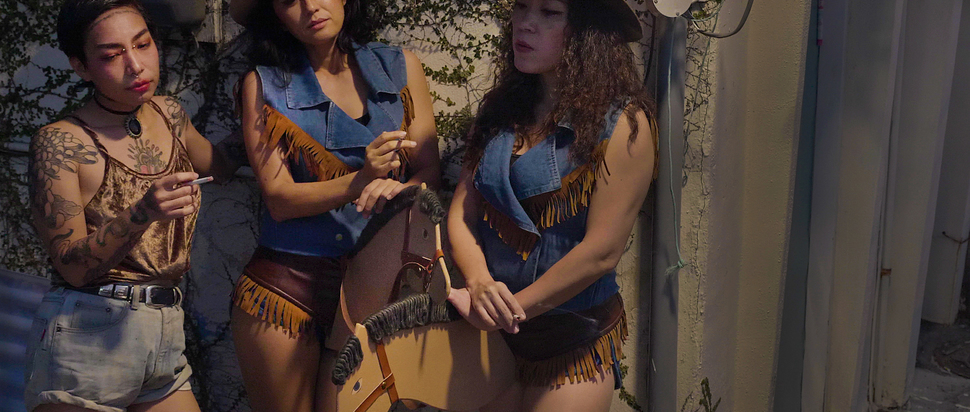The War is Not Over: Chikako Yamashiro interview
Chikako Yamashiro's exhibition is now open at Dundee Contemporary Arts. Here, the artist and guest curator Kirsteen Macdonald explain that the works are complex expressions of the contested politics of Okinawa, but have a wider resonance, too
Okinawan artist-filmmaker Chikako Yamashiro’s solo exhibition at Dundee Contemporary Arts has – like a lot of shows over the last few months – been a long time coming, and not just because of recent pandemic postponements. The works in the show also extend much further back into timelines that include the social, political and cultural histories and traditions of Okinawa, where the artist is from and lives.
The three works in DCA include two previous works and one of Yamahshiro’s most recent films, titled Chinbin Western. “Okinawa is not the filmic backdrop, it is a character in the work,” says Macdonald. The Japanese prefecture of over 150 islands has been subject to military occupation by the US since the Second World War. A situation all the more complicated by the triangular power dynamic of the Japanese Government, US interests and the Okinawan population – who voted against the continuing presence of US military forces in a local referendum that was largely ignored. "Since World War II," Yamashiro explains, "70% of Japan's US military bases remained on the tiny island of Okinawa. Therefore people say that the war is not over yet."
For the artist, her relationship with the context of Okinawa has developed and changed. “If you get caught up in the vast historical flow of Okinawa you can end up getting so transfixed that there’s no going back.” Suggesting the special turning point that Chinbin Western represents in her own artistic development, Yamashiro continues: “Over the space of about ten years, experiencing both the joy and the pain associated with the tidal force of Okinawa’s history, I myself and many other people who live here finally started to speak in their own voices.”
In itself, Chinbin Western: Representation of the Family (the full title) is a narrative film, that experiments with storytelling and allegory. It centres on two different families; in one of which the father is part of the quarrying that is taking place to create a new landmass in Henoko for a new US military base. “I wanted to portray the family of a man who has no choice but to work as an earth miner, who never leaves his hometown while trying to protect his family's happiness," says Yamashiro. "I wanted to portray [at the same time a different] family of grandchildren and grandfathers who protect the sanctuary left in their hometown.“
The operatic song-form of arias are used at points for characters to communicate, and as a deliberate reference to European cultural imports. These feature seamlessly alongside tsurane ryuka, a genre of narrative song that is particular to Okinawa. In parallel, there’s also a play within the film that is performed in the costume of the Ryukyu Kingdom (1429-1879). This is performed at the site of the quarry itself. It’s a mountainous region that has for 65 years been exploited for the purpose of creating the new US military base. In reality, the people that lived there for the last 600 years were displaced in order for the quarrying to take place. While there is a cluster of ten households remaining, these are likely to be gone within the next two decades.
One distinctive feature of Chinbin Western is its close alignment of actors and the roles they play. For instance, the tattooed and pierced character who plays an artist in the film, is herself an opera singer and artist. It’s one subtle strategy that evidences some of Yamashiro’s interesting relationship with “a cinematic approach”. Yamashiro says, “The aim is not creating an informative film that depicts a historical fact, rather it's a process in which image is seen first and then visualised. The main purpose is to convey the reverberating emotions and circulating voices of all who live together.”
Speaking of her aspirations for the more general relevance of her work, Yamashiro says “there are people in many nations and regions who live under the influence of the scars left behind by war and history, and fissures are appearing in various places under this state of the ongoing COVID-19 pandemic. I think that asking questions to people outside of Okinawa and overseas too through the highly abstracted language of art makes the subject more accessible.”
Is it ever hard for Yamashiro to make work about a live situation that is not just on her doorstep, but threaded through every aspect of her immediate environment? Her reply to this final question is unequivocal and inspiring. "It is not difficult at all to create works for me as there are so many themes to be depicted and I will continue to create works in order to live."
Chikako Yamashiro: Chinbin Western, Dundee Contemporary Arts, until 21 Nov
